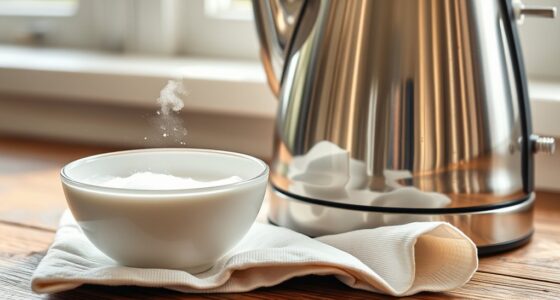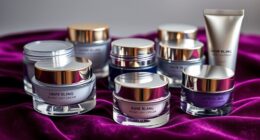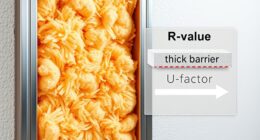To choose the right grinder burrs, you’ll want to think about their types, materials, and sizes. Blade burrs chop beans unevenly, while flat and conical burrs grind more uniformly and are better for precision brewing. Materials like ceramic or steel affect durability and maintenance needs. Larger burrs provide consistent particle sizes, improving flavor. Proper upkeep extends burr life and performance. Keep exploring to get detailed guidance on selecting the best options for your brewing style and needs.
Key Takeaways
- Identify whether the grinder uses blade, flat, or conical burrs to determine grind consistency and suitability for brewing methods.
- Consider burr material options such as ceramic or steel for durability, heat resistance, and maintenance needs.
- Match burr size and shape to your brewing style to ensure optimal grind uniformity and flavor extraction.
- Evaluate long-term performance factors like wear resistance, ease of cleaning, and cost-effectiveness for your usage level.
- Establish a regular maintenance routine to preserve burr sharpness, grind consistency, and overall grinder efficiency.
Blade Burrs vs. Flat Burrs: Understanding the Basic Differences
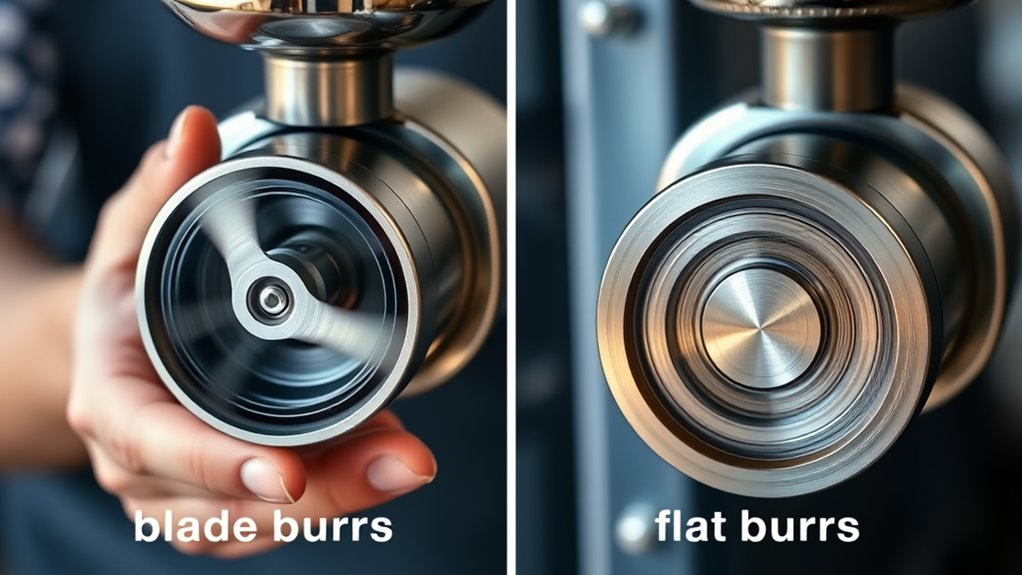
While both blade burrs and flat burrs are common in coffee grinders, they serve different purposes and produce distinct results. Blade burrs chop beans unevenly, which can lead to inconsistent grind sizes and uneven extraction. If your grind becomes inconsistent, you might need burr sharpening or burr replacement to restore performance. Flat burrs, on the other hand, grind beans more uniformly, making them ideal for precision brewing methods. Over time, flat burrs can dull, reducing grind consistency, so regular burr sharpening or replacement is essential for maintaining quality. Understanding these differences helps you choose the right grinder for your needs and know when to perform maintenance, ensuring each brew is fresh, flavorful, and consistent. Additionally, regular maintenance is crucial in preventing issues like dullness and ensuring optimal performance of your burrs.
Conical Burrs: Features and Benefits for Home and Commercial Use
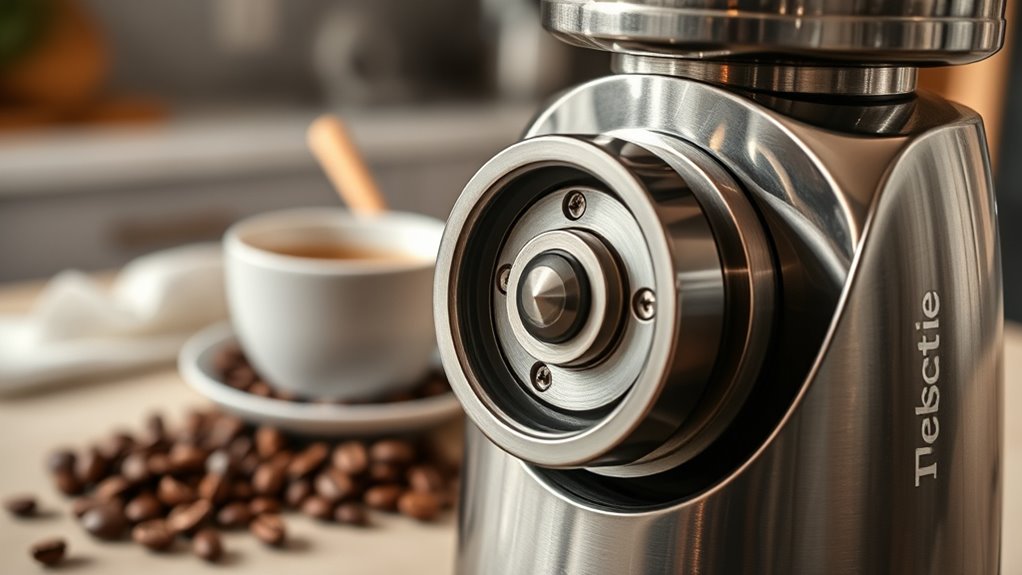
Conical burrs are highly valued for their ability to produce consistent grinds with minimal heat buildup, making them an excellent choice for both home and commercial coffee setups. Their conical shape allows for gentle, even grinding, reducing the risk of overheating that can affect flavor. For home brewing, conical burrs offer precision and durability, ensuring you get a uniform grind every time. They handle a wide range of grind sizes, from coarse to fine, ideal for various brewing methods like French press or espresso. In commercial settings, conical burrs maintain efficiency and consistency under heavy use. Their design minimizes static and retention, helping you keep your coffee fresh and flavorful. Additionally, the factors affecting grind consistency are important to consider when selecting conical burrs for optimal performance. Whether for casual home brewing or professional use, conical burrs deliver reliable performance and excellent quality.
Flat Burrs: Advantages and Ideal Brewing Methods

Have you considered how flat burrs can enhance your coffee experience? Their uniform grind size promotes consistent flavor extraction, which is key for brewing methods like espresso and pour-over. Flat burrs produce a more even grind, reducing variability and ensuring each shot or brew maintains its quality. They excel at precise control over grind size, so you can fine-tune your settings for ideal results. Here’s a quick comparison:
| Feature | Ideal Brewing Method |
|---|---|
| Uniform grind size | Espresso, pour-over |
| Consistent flavor extraction | Aeropress, cold brew |
| Precise grind control | Specialty brewing |
| Reduced fines | Filter coffee |
| Better for espresso | High-pressure extraction |
Additionally, their design minimizes burr wear, extending the lifespan of your grinder and maintaining consistent performance over time.
Material Options: Ceramic, Steel, and Other Durability Factors
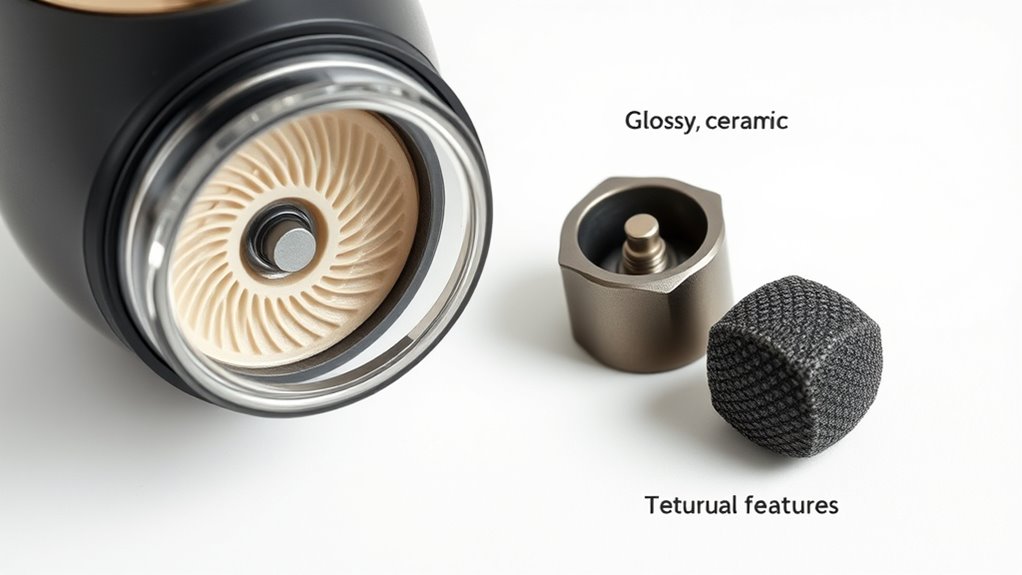
Choosing the right burr material is essential for durability and performance. Your selection impacts how well your grinder withstands daily use and maintains consistent results. Ceramic burrs are known for their resistance to heat and corrosion, making them a durable option if you want longevity and minimal wear. Steel burrs, especially hardened steel, offer excellent durability factors, providing sharpness and strength that handle tough beans and frequent grinding. Other materials, like composite or ceramic-steel blends, aim to balance performance with durability. Keep in mind that different burr materials may wear differently over time, affecting grind consistency. Ultimately, understanding the durability factors associated with each burr material helps you choose a grinder that performs reliably and lasts longer, saving you money and hassle in the long run.
Burr Size and Grind Consistency: How It Affects Your Coffee
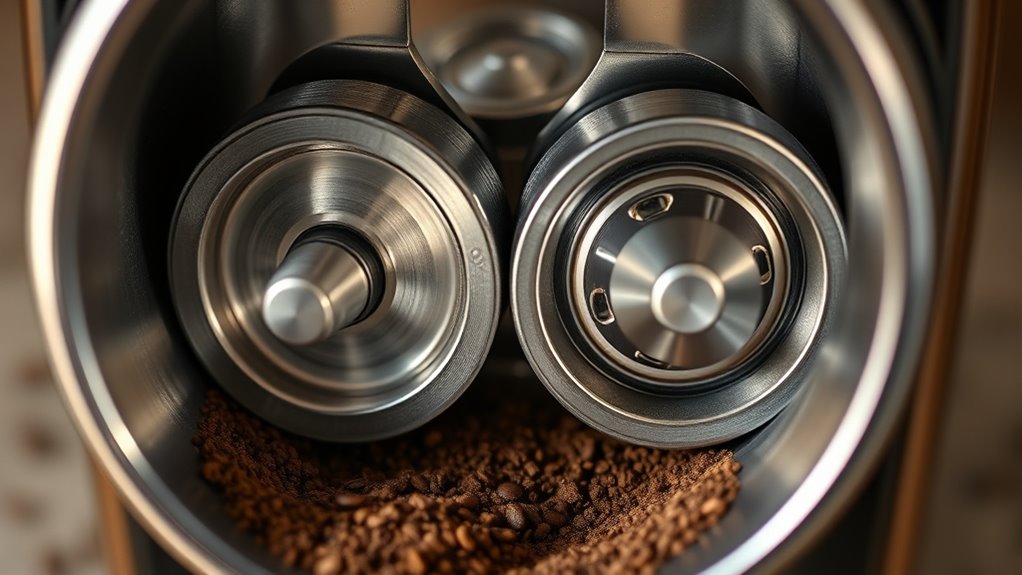
Burr size directly influences the uniformity of particle size, which affects how evenly your coffee extracts. When grind consistency is off, it can lead to over- or under-extraction, changing your flavor profile. Understanding this relationship helps you optimize your grinder settings for the best-tasting brew. Additionally, selecting the appropriate burr type can improve grind consistency and overall brewing results.
Uniformity of Particle Size
The uniformity of particle size plays a crucial role in brewing a balanced and flavorful cup of coffee. When your burrs are sharp through proper burr sharpening, grind consistency improves, ensuring each particle is similar in size. This uniformity allows for more precise grind adjustment, giving you control over extraction. Inconsistent particle sizes can cause over- or under-extraction, leading to dull or sour flavors. To optimize, regularly maintain your burrs and fine-tune your grind adjustment. Remember, a consistent grind results in a better-tasting brew. Additionally, understanding burr types can help you select the right grinder for optimal performance.
Impact on Extraction Rate
Since grind consistency directly influences how quickly and evenly coffee extracts, maintaining proper burr size and uniform particle size is essential. Larger burrs typically produce a more uniform grind, leading to a steadier extraction rate. This consistency helps prevent over-extraction or under-extraction, resulting in better flavor. Conversely, inconsistent particle sizes can slow down extraction or cause uneven brewing, affecting taste and strength. Additionally, burr size impacts grinder noise—larger burrs often run more smoothly and quietly. Keep in mind, higher-quality burrs may come with increased cost considerations, but they often deliver better extraction performance. Ultimately, choosing the right burr size balances your desired extraction speed, noise levels, and budget, ensuring optimal coffee quality.
Flavor Profile Consistency
Because grind consistency directly influences the flavor profile of your coffee, maintaining uniform particle size is essential for achieving a balanced and nuanced taste. When your burrs are sharp through regular burr sharpening, you can better control grind size and avoid uneven extraction. Consistent grind adjustment ensures each brew has the same flavor characteristics, preventing over- or under-extraction. Variations in burr size or dull burrs lead to inconsistent particle distribution, causing flavor fluctuations. Regularly checking and maintaining your burrs helps preserve flavor profile consistency, highlighting subtle notes and maintaining clarity. Proper burr maintenance is vital for consistent performance and flavor fidelity in every cup. By prioritizing burr sharpening and precise grind adjustments, you ensure your coffee’s flavor remains steady, allowing the true essence of your beans to shine through with every cup.
Maintenance Considerations for Different Burr Types
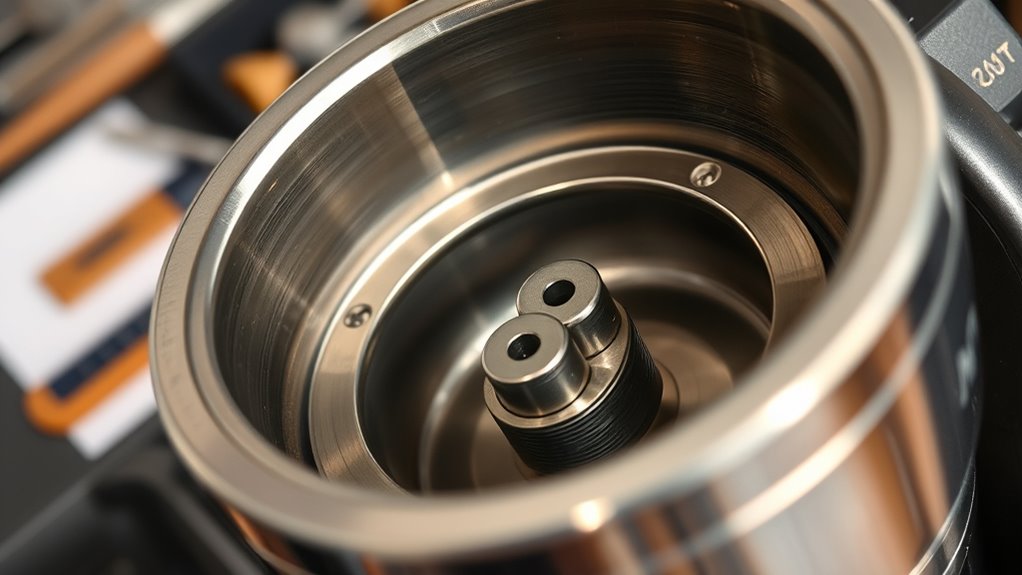
Different burr materials have varying levels of durability, which can impact how often you need to contemplate or sharpen them. You’ll also want to consider cleaning frequency, as some materials attract more coffee residue or oils. Understanding these maintenance needs helps keep your grinder performing at its best. Incorporating protective styling benefits into your maintenance routine can also extend the lifespan of your burrs by reducing unnecessary wear.
Burr Material Durability
The durability of your grinder’s burr material considerably impacts maintenance and long-term performance. A sturdy burr material resists wear, helping to keep grinder noise consistent over time and ensuring smooth operation. When your burrs are made from robust materials, they maintain sharpness longer, reducing the need for frequent replacements and keeping energy efficiency high. Weaker materials tend to dull faster, causing your grinder to work harder and consume more power, which also increases noise levels. Investing in high-quality, resilient burrs minimizes maintenance costs and helps your grinder perform ideally for years. Different materials have varying wear rates, so choosing the right one based on your usage can save you money and effort in the long run. Additionally, understanding the wear characteristics of different burr materials can aid in selecting the most durable option for your needs.
Cleaning Frequency Needs
Cleaning frequency varies considerably depending on your burr type, as some materials attract more residue or are prone to buildup. For example, metal burrs may require less frequent cleaning but can cause increased grinder noise if clogged. Ceramic burrs tend to stay cleaner longer, reducing maintenance needs, which benefits portability features by keeping your grinder quieter and more efficient on the go. If you use your grinder daily, expect to clean it every few weeks; less frequent use means less frequent cleaning. Proper maintenance ensures consistent grind quality and minimizes noise during operation. Regular cleaning also prevents residue buildup that can affect the grinder’s performance and longevity. Additionally, understanding automated systems‘ role in maintenance can help optimize your cleaning schedule, ensuring your grinder remains in top condition. Adjust your cleaning schedule based on your usage and burr material to keep your grinder functioning smoothly and quietly.
Choosing the Right Burrs Based on Your Brewing Style and Needs
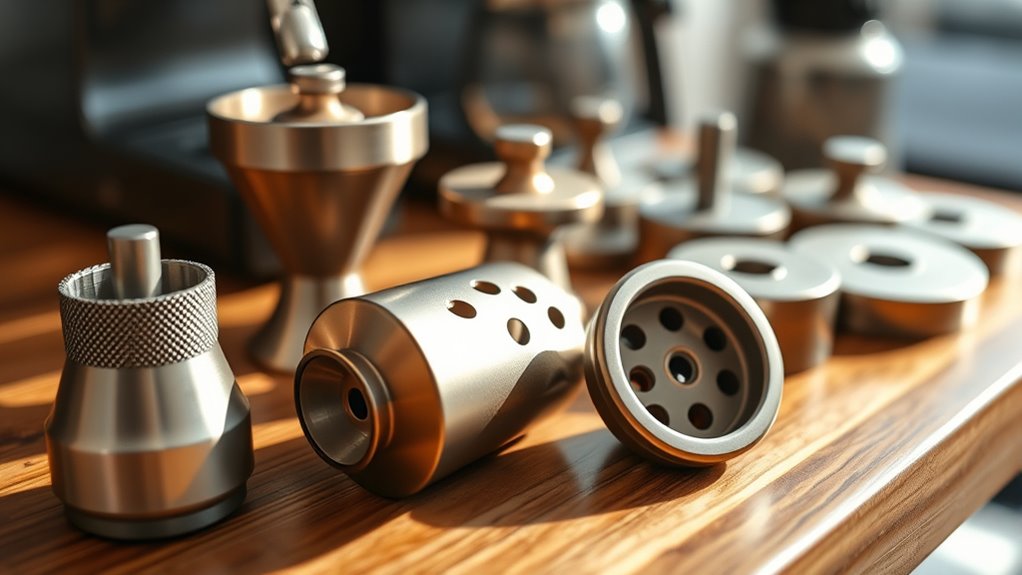
Choosing the right burrs depends heavily on your brewing style and how you prioritize flavor, consistency, and speed. Your choice impacts burr alignment and motor compatibility, guaranteeing peak performance. For delicate, nuanced flavors, opt for burrs with fine grind adjustments and precise burr alignment. If brewing quickly for large volumes, focus on burrs designed for speed and durability, often with larger diameters.
Additionally, understanding the personality traits associated with different brewing methods can help optimize your equipment choices for better results. Consider these factors:
- Burr alignment: Ensures consistent grind size and prevents uneven extraction.
- Motor compatibility: Match your grinder’s motor power with burr size to avoid overheating or damage.
- Brewing style: Espresso demands fine, precise burrs, while French press needs coarser ones for peak extraction.
Frequently Asked Questions
Which Burr Type Is Best for Espresso Versus French Press?
For espresso, you want a conical or flat burr made of high-quality materials like ceramic or steel, which provide consistent grinding and preserve flavor. This guarantees the fine, uniform grind needed for extraction. For French press, a burr with a coarser grind setting works best, often made of durable steel, to produce a consistent, coarse grind. Your choice of burr material and grinding consistency directly impacts your brewing quality.
How Do Burrs Affect the Flavor Profile of Coffee?
Burrs directly impact your coffee’s flavor profile by influencing flavor extraction and aroma retention. When you use high-quality burrs, they produce a consistent grind size, which allows water to extract flavors evenly, enhancing the coffee’s richness. This consistency also locks in aroma, making your brew more vibrant and aromatic. Conversely, worn or inconsistent burrs can cause uneven extraction, dulling flavors and diminishing the aromatic complexity you enjoy.
Can I Upgrade My Grinder’s Burrs Later?
Yes, you can upgrade your grinder’s burrs later. Many grinders offer burr replacement or upgrade options, allowing you to improve your coffee experience over time. Investigating this reveals that upgrading burrs often enhances grind consistency and flavor extraction. Check your grinder’s model and manufacturer’s recommendations to guarantee compatibility. Upgrading is a smart move if you’re aiming for better flavor, precision, and longevity from your coffee setup.
Are There Specific Maintenance Tips for Ceramic Versus Steel Burrs?
Yes, ceramic and steel burrs require different maintenance. For ceramic burrs, use a soft brush for cleaning and avoid harsh chemicals to prevent chipping, maintaining compatibility with their delicate material. Steel burrs are tougher; you should clean them more frequently with a brush or cloth to remove coffee oils and debris, ensuring peak performance. Always follow manufacturer guidelines for your specific burr material to keep your grinder in top shape.
What Is the Typical Lifespan of Different Burr Materials?
Did you know steel burrs typically last 5 to 10 years, while ceramic ones can go up to 15 years? Your choice impacts burr durability and material longevity. Steel tends to be more durable under heavy use, but ceramic’s wear resistance makes it ideal for lighter grinding. To maximize lifespan, follow proper maintenance routines, and avoid overloading your grinder, ensuring your burrs serve you well for years to come.
Conclusion
Choosing the right burrs is like finding the perfect musical instrument—you’ll create harmony in every cup. Whether you prefer the sharp precision of flat burrs or the graceful efficiency of conical ones, understanding their differences helps you craft your ideal brew. Think of your grinder as a trusty compass, guiding you through flavor landscapes. With proper care and the right choice, your coffee journey becomes an artful dance, turning everyday beans into extraordinary symphonies.






